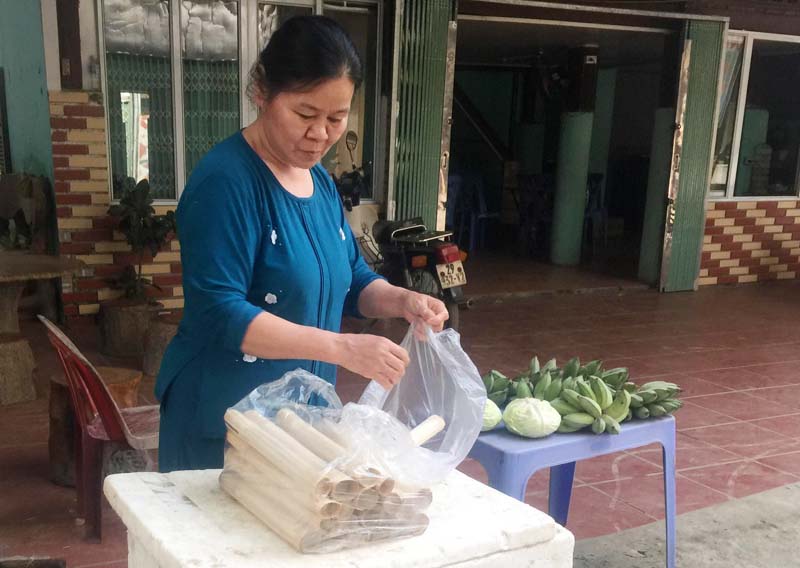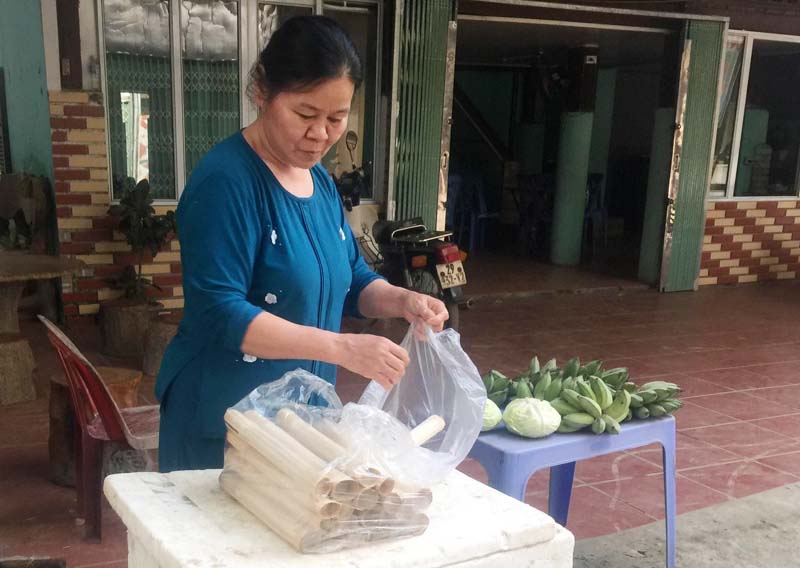



Lam
rice is sold at the gate of Kim Boi Mineral Spring Ecotourism site.
The processing of
rice is so simple that almost any person born in the North West forest knows
how to make. The first step is to select the bamboo tube. In order to have
delicious and beautiful rice, you have to choose the fresh bamboo, dark green cover;
then, chop into pieces with the length of about 30cm. The next step is choosing
sticky rice: it must be yellow flower sticky rice with round fragrant milky white
seeds.
At first, clean the
rice, soak for 6-8 hours, then pick up to the basket for dryness. Next, pour
the rice into the tube, fill the rice with water and cover the tube with the
dried banana leaves or the sugar cane cut into small pieces of 3 cm long. It is
noted that when filling the rice, do not fill the tube fully but with a small
space so that when being cooked, the rice will fill the mouth of the tube.
When all of the preparation
is complete, the Lam rice tubes will be baked on fire. While baking, constantly
turn the tubes for evenly cooked Lam Rice. Notice that when the water is vapored
from the scented lid, which means the rice is well cooked. Use a knife to remove
the outer shell, leaving only a thin layer. When eating, peeling and eating
with sesame salt or simply white salt is also very delicious.
Nowadays, as the
society grows sharply, the demand of people is increasingly higher; the way to
make Lam Rice is a little different. Besides the usual Lam Rice, there is also Lam
Rice with coconut juice, five – colored Lam Rice, Lam Rice with peanut, etc.
Local people no longer make Lam Rice to eat when going to the forest anymore but
it has become attached closely to their daily life.
Not only that, this
simple and casual dish has become the brand of Hoa Binh.
Holding in my arms with
a Lam Rice - a product of my ethnic group, it is hardly to describe my
difficult emotion in my heart. As a child of Muong ethnic land, I was born and grew
up in the cradle of national culture; I always treasure the products of typical
national culture. And above all, it is so exciting to know our products are
introduced to visitors coming to Hoa Binh.
Ms. Bui Thi Nguyen,
a longtime cook of Lam Rice at Kim Boi Mineral Springs (Kim Boi district),
said: "In recent years, tourists have been buying more and more Lam rice, partially
as a dish to eat immediately and partially as a gift for their friends and
relatives. Thanks to cooking Lam Rice, the economy of my family and some other
households cooking Lam Rice has been improved gradually.
Sharing with us
while selecting Lam Rice to buy, Mr. Mai Dinh Tu (Chua Ha Street, Cau Giay
District, Hanoi) said: "I often take my wife and children to Hoa Binh for
relaxation. Each time I come there, I always buy Lam Rice as souvenirs. Everyone
at my office and family like it very much. Every time I had the chance to come
to Hoa Binh, they also asked me to buy Lam Rice."